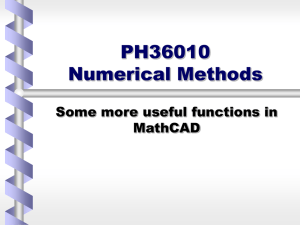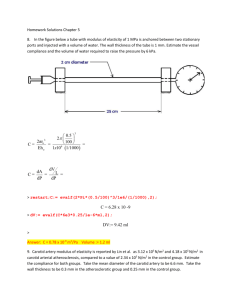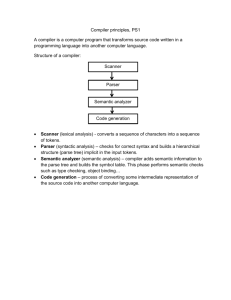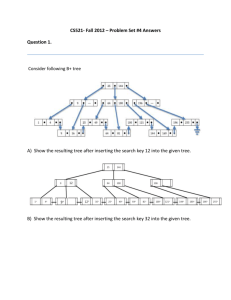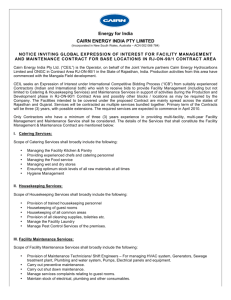S2 File
advertisement
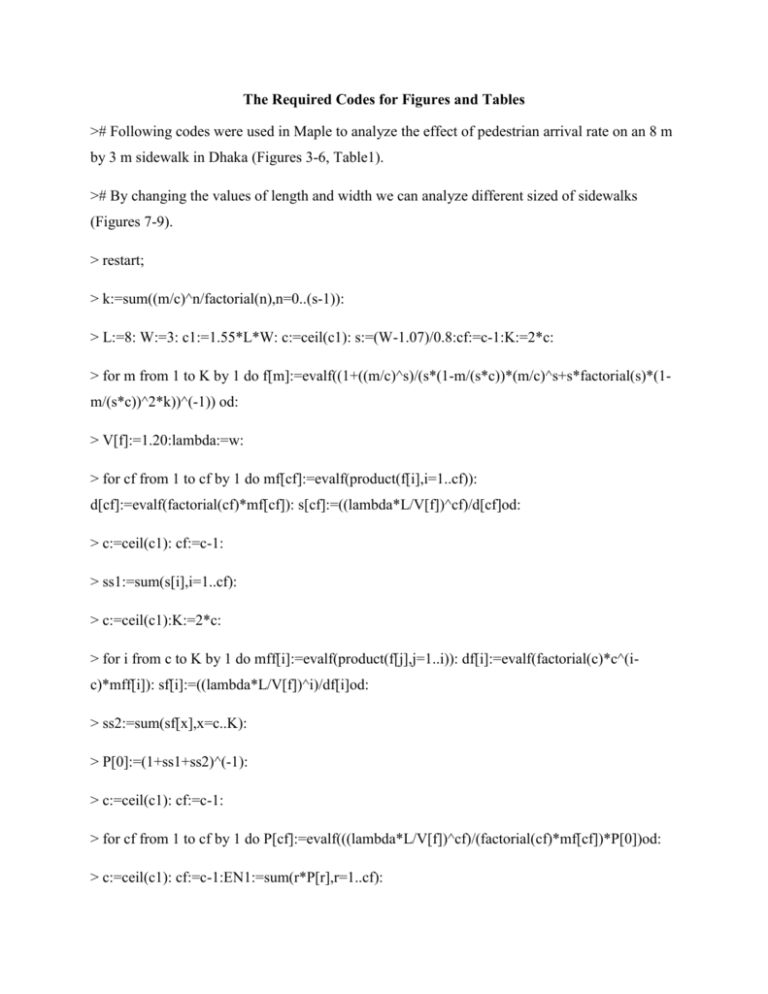
The Required Codes for Figures and Tables
># Following codes were used in Maple to analyze the effect of pedestrian arrival rate on an 8 m
by 3 m sidewalk in Dhaka (Figures 3-6, Table1).
># By changing the values of length and width we can analyze different sized of sidewalks
(Figures 7-9).
> restart;
> k:=sum((m/c)^n/factorial(n),n=0..(s-1)):
> L:=8: W:=3: c1:=1.55*L*W: c:=ceil(c1): s:=(W-1.07)/0.8:cf:=c-1:K:=2*c:
> for m from 1 to K by 1 do f[m]:=evalf((1+((m/c)^s)/(s*(1-m/(s*c))*(m/c)^s+s*factorial(s)*(1m/(s*c))^2*k))^(-1)) od:
> V[f]:=1.20:lambda:=w:
> for cf from 1 to cf by 1 do mf[cf]:=evalf(product(f[i],i=1..cf)):
d[cf]:=evalf(factorial(cf)*mf[cf]): s[cf]:=((lambda*L/V[f])^cf)/d[cf]od:
> c:=ceil(c1): cf:=c-1:
> ss1:=sum(s[i],i=1..cf):
> c:=ceil(c1):K:=2*c:
> for i from c to K by 1 do mff[i]:=evalf(product(f[j],j=1..i)): df[i]:=evalf(factorial(c)*c^(ic)*mff[i]): sf[i]:=((lambda*L/V[f])^i)/df[i]od:
> ss2:=sum(sf[x],x=c..K):
> P[0]:=(1+ss1+ss2)^(-1):
> c:=ceil(c1): cf:=c-1:
> for cf from 1 to cf by 1 do P[cf]:=evalf(((lambda*L/V[f])^cf)/(factorial(cf)*mf[cf])*P[0])od:
> c:=ceil(c1): cf:=c-1:EN1:=sum(r*P[r],r=1..cf):
> for i from c to K by 1 do P[i]:=evalf(((lambda*L/V[f])^i)/(factorial(c)*c^(i-c)*mff[i])*P[0])od:
> c:=ceil(c1): K:=2*c: EN2:=sum(t*P[t],t=c..K):
> EN:=EN1+EN2:
> c:=ceil(c1): K:=2*c:theta:=lambda*(1-P[K]):
> ET:=EN/theta:
> c:=ceil(c1): K:=2*c: Q:=sum((t-c)*P[t],t=(c+1)..K):
> with(plots):
> plot([P[K]],w=0..9,labels=["Arrival Rate(ped/sec)","The Probability of Balking
(P[K])"],labeldirections=['horizontal','vertical'],thickness=2,axes=box, color=black,
font=[COURIER,BOLD,12], legend=["Length=8m,Width=3m, vf=1.2"],
legendstyle=[location=top]):
> plot([Q],w=0..9,labels=["Arrival Rate(ped/sec)","No. of Pedestrains in Queue
(ped)"],labeldirections=['horizontal','vertical'],thickness=2,axes=box, color=black,
font=[COURIER,BOLD,12], legend=["Length=8m,Width=3m, vf=1.2"],
legendstyle=[location=top]):
> plot([ET],w=0..9,labels=["Arrival Rate(ped/sec)","Expected Amount of Time on the
Facility(sec)"],labeldirections=['horizontal','vertical'],thickness=2 ,axes=box, color=black,
font=[COURIER,BOLD,12], legend=["Length=8m,Width=3m, vf=1.2"],
legendstyle=[location=top]):
> plot([theta],w=0..9,labels=["Arrival
Rate(ped/sec)","Throughput(ped/sec)"],labeldirections=['horizontal','vertical'],thickness=2,axes=
box, color=black, font=[COURIER,BOLD,12], legend=["Length=8m,Width=3m, vf=1.2"],
legendstyle=[location=top]):
>
> #plot([EN],w=0..9,labels=["Arrival Rate","No of Pedestrains on the
Facility"],labeldirections=['horizontal','vertical'],thickness=2,title="Expected Number of
Pedestrians on the Facility for different Arrival Rates" ,axes=box, color=black,
font=[COURIER,BOLD,12], titlefont=[TIMES,ROMAN,12], legend=["Length=8m,Width=3m,
vf=1.2"], legendstyle=[location=top]);
># Following codes were used in R to analyze the effect of width on performances ( theta) in
Figure 10 and Table 2.
getParam <- function(w=2.67,l=8,lambda=6,vf=1.2)
{
c<-ceiling(1.55*l*w)
s<-(w-1.07)/0.8
s1<-s-1
c1<-c-1
c2<-c+1
k<-2*c
es<-l/vf
m<-seq(1,k)
m_c<-m-c
mc<-m/c
ksum<-0
for(i in 0:s1){ksum<-ksum+mc^i/factorial(i)}
f<-1/(1+mc^s/(s*(1-mc/s)*mc^s+s*factorial(s)*(1-mc/s)^2*ksum))
d<-cumprod(f)
d[1:c1]<-factorial(m[1:c1])*d[1:c1]
d[c:k]<-factorial(c)*c^(m[c:k]-c)*d[c:k]
d<-(lambda*es)^m/d
p0<-1/(1+sum(d))
p<-p0*d
pb<-p[k]
theta<-lambda*(1-pb)
et<-sum(m*p)/theta
eq<-sum(m_c[c2:k]*p[c2:k])
rsl<-c(W=w,L=l,Lambda=lambda,Vf=vf,Pb=pb,EQ=eq,ET=et,Theta=theta)
return(rsl)
}
#replace .1 in w below by .01 to get more points
w<-seq(2.68,5,.1)
n<-length(w)
rslt<-matrix(rep(NA,n*8),n,8)
t<-rep(NA,n)
for(i in 1:n){x<-getParam(w[i],l=8,lambda=6,vf=1.2);for(j in 1:8){rslt[i,j]<-x[j]};t[i]<-x[8]}
plot(w,t,type="l",xlab="Width (m)",ylab="Throughput (ped/sec)")
nm<-c("W", "L", "Lambda", "Vf", "Pb", "EQ", "ET", "Theta")
rslt1<-t(rslt)
row.names(rslt1)<-nm
rslt<-t(rslt1)
rslt
># Result from the R was then used in Maple to draw the Figure 10
> restart;
> with(plottools);
> with(plots);
> pointplot([[2.68, 0.6521238e-1], [2.78, .70839877], [2.88, 1.31854096], [2.98, 1.88582812],
[3.08, 2.47566693], [3.18, 2.97522609], [3.28, 3.44411060], [3.38, 3.89418520], [3.48,
5.06157732], [3.58, 5.66616312], [3.68, 5.93579200], [3.78, 5.99051611], [3.88, 5.99962618],
[3.98, 5.99994990], [4.08, 5.99999306], [4.18, 5.99999901], [4.28, 5.99999998], [4.38,
6.00000000], [4.48, 6.00000000], [4.58, 6.00000000], [4.68, 6.00000000], [4.78, 6.00000000],
[4.88, 6.00000000], [4.98, 6.00000000], [8, 6.00000000]], style = line, labels = ["Width (m)",
"Throughput(ped/sec)"], labeldirections = ['horizontal', 'vertical'], thickness = 2, axes = box,
color = black, font = [COURIER, BOLD, 12], legend = "Length=8 m,Width=3 m, vf=1.2",
legendstyle = [location = top]);
># Following codes were used in Maple to analyze the effect of length on performances (P[K];
Q; ET; theta) in Tables 3 and 4.
># By changing the values of length we can analyze different sized of sidewalks
> restart;
> k:=sum((m/c)^n/factorial(n),n=0..(s-1)):
> L:=8: W:=3: c1:=1.55*L*W: c:=ceil(c1): s:=(W-1.07)/0.8:cf:=c-1:K:=2*c:
> for m from 1 to K by 1 do f[m]:=evalf((1+((m/c)^s)/(s*(1-m/(s*c))*(m/c)^s+s*factorial(s)*(1m/(s*c))^2*k))^(-1)) od:
> V[f]:=1.20:lambda:=6:
> for cf from 1 to cf by 1 do mf[cf]:=evalf(product(f[i],i=1..cf)):
d[cf]:=evalf(factorial(cf)*mf[cf]): s[cf]:=((lambda*L/V[f])^cf)/d[cf]od:
> c:=ceil(c1): cf:=c-1:
> ss1:=sum(s[i],i=1..cf):
> c:=ceil(c1):K:=2*c:
> for i from c to K by 1 do mff[i]:=evalf(product(f[j],j=1..i)): df[i]:=evalf(factorial(c)*c^(ic)*mff[i]): sf[i]:=((lambda*L/V[f])^i)/df[i]od:
> ss2:=sum(sf[x],x=c..K):
> P[0]:=(1+ss1+ss2)^(-1):
> c:=ceil(c1): cf:=c-1:
> for cf from 1 to cf by 1 do P[cf]:=evalf(((lambda*L/V[f])^cf)/(factorial(cf)*mf[cf])*P[0])od:
> c:=ceil(c1): cf:=c-1:EN1:=sum(r*P[r],r=1..cf):
> for i from c to K by 1 do P[i]:=evalf(((lambda*L/V[f])^i)/(factorial(c)*c^(i-c)*mff[i])*P[0])od:
> c:=ceil(c1): K:=2*c: EN2:=sum(t*P[t],t=c..K):
> EN:=EN1+EN2:
> c:=ceil(c1): K:=2*c:theta:=lambda*(1-P[K]):
> ET:=EN/theta:
> c:=ceil(c1): K:=2*c: Q:=sum((t-c)*P[t],t=(c+1)..K):
> P[K];
> Q;
> ET;
> theta;
># Following codes were used in Maple for Figures 11-12 and Tables 5-6.
> restart;
> k:=sum((m/c)^n/factorial(n),n=0..(s-1)):
> L:=10: W:=2.8: c1:=1.55*L*W: c:=ceil(c1): s:=(W-1.07)/0.8:cf:=c-1:K:=2*c:
> for m from 1 to K by 1 do f[m]:=evalf((1+((m/c)^s)/(s*(1-m/(s*c))*(m/c)^s+s*factorial(s)*(1m/(s*c))^2*k))^(-1)) od:
> V[f]:=w:lambda:=4:
> for cf from 1 to cf by 1 do mf[cf]:=evalf(product(f[i],i=1..cf)):
d[cf]:=evalf(factorial(cf)*mf[cf]): s[cf]:=((lambda*L/V[f])^cf)/d[cf]od:
> c:=ceil(c1): cf:=c-1:
> ss1:=sum(s[i],i=1..cf):
> c:=ceil(c1):K:=2*c:
> for i from c to K by 1 do mff[i]:=evalf(product(f[j],j=1..i)): df[i]:=evalf(factorial(c)*c^(ic)*mff[i]): sf[i]:=((lambda*L/V[f])^i)/df[i]od:
> ss2:=sum(sf[x],x=c..K):
> P[0]:=(1+ss1+ss2)^(-1):
> c:=ceil(c1): cf:=c-1:
> for cf from 1 to cf by 1 do P[cf]:=evalf(((lambda*L/V[f])^cf)/(factorial(cf)*mf[cf])*P[0])od:
> c:=ceil(c1): cf:=c-1:EN1:=sum(r*P[r],r=1..cf):
> for i from c to K by 1 do P[i]:=evalf(((lambda*L/V[f])^i)/(factorial(c)*c^(i-c)*mff[i])*P[0])od:
> c:=ceil(c1): K:=2*c: EN2:=sum(t*P[t],t=c..K):
> EN:=EN1+EN2:
> c:=ceil(c1): K:=2*c:theta:=lambda*(1-P[K]):
> ET:=EN/theta:
> c:=ceil(c1): K:=2*c: Q:=sum((t-c)*P[t],t=(c+1)..K):
> with(plots):
> plot([P[K]],w=0.1..2,labels=["Pedestrian Free Flow Speed (m/sec)","The Probability of
Balking (P[K])"],labeldirections=['horizontal','vertical'],thickness=2,axes=box, color=black,
font=[COURIER,BOLD,12], legend=["Length=10m,Width=2.8m, lambda=4ped/sec"],
legendstyle=[location=top]);


